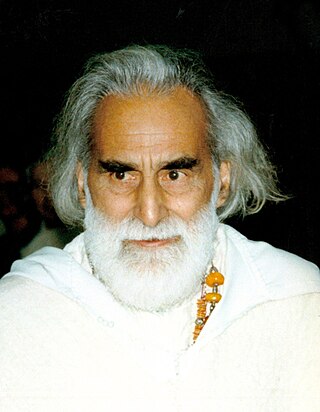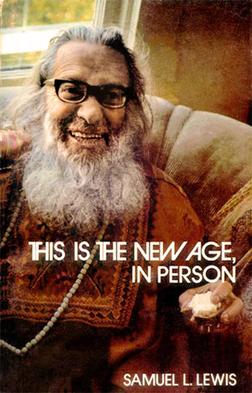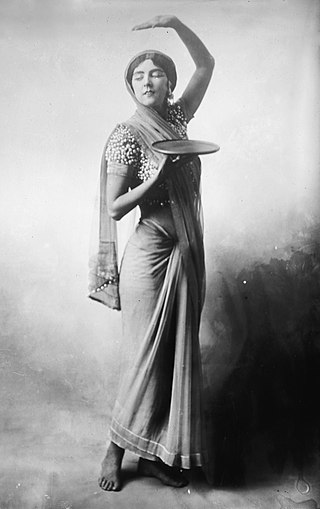
Inayat Khan Rehmat Khan was an Indian professor of musicology, singer, exponent of the saraswati vina, poet, philosopher, and pioneer of the transmission of Sufism to the West. At the urging of his students, and on the basis of his ancestral Sufi tradition and four-fold training and authorization at the hands of Sayyid Abu Hashim Madani of Hyderabad, he established an order of Sufism in London in 1914. By the time of his death in 1927, centers had been established throughout Europe and North America, and multiple volumes of his teachings had been published.

Vilayat Inayat Khan was a teacher of meditation and of the traditions of the East Indian Chishti Sufi order of Sufism. His teaching derived from the tradition of his father, Inayat Khan, founder of The Sufi Order in the West, in a form tailored to the needs of Western seekers. One of his sisters was Noor Inayat Khan GC MBE. He taught in the tradition of Universal Sufism. His parents met at the New York City ashram of American yogi, Pierre Bernard, half-brother of his mother Pirani Ameena Begum.

The perennial philosophy, also referred to as perennialism and perennial wisdom, is a perspective in philosophy and spirituality that views religious traditions as sharing a single, metaphysical truth or origin from which all esoteric and exoteric knowledge and doctrine has grown.

Samuel L. Lewis also known as Murshid Samuel Lewis and Sufi Ahmed Murad Chisti was an American mystic and horticultural scientist who founded what became the Sufi Ruhaniat International, a branch of the Chishtia Sufi lineage. After a lifetime of spiritual study with teachers East and West, primarily Inayat Khan and Nyogen Senzaki, Lewis was recognized simultaneously as a Zen master and Sufi murshid by Eastern representatives of the two traditions. He also co-founded the Christian mystical order called the Holy Order of Mans. His early interest in international seed exchange and organic agriculture also established him as one of the pioneers of green spirituality. His most enduring legacy may be the creation of the Dances of Universal Peace, an early interspiritual practice that has spread around the world in the 50 years since his death.

Ruth St. Denis was an American pioneer of modern dance, introducing eastern ideas into the art and paving the way for other women in dance. She was inspired by the Delsarte advocate Genevieve Stebbins. St. Denis was the co-founder in 1915 of the American Denishawn School of Dancing and Related Arts. She taught notable performers including Martha Graham and Doris Humphrey. In 1938, she founded the pioneering dance program at Adelphi University. She published several articles on spiritual dance and the mysticism of the body.

Sacred dance is the use of dance in religious ceremonies and rituals, present in most religions throughout history and prehistory. Its connection with the human body and fertility has caused it to be forbidden by some religions; for example, some branches of Christianity and Islam have prohibited dancing. Dance has formed a major element of worship in Hindu temples, with strictly formalized styles such as Bharatanatyam, which require skilled dancers and temple musicians. In the 20th century, sacred dance has been revived by choreographers such as Bernhard Wosien as a means of developing community spirit.

Hidayat Inayat Khan was a British-French classical composer, conductor and Representative-General of the Inayati Order.

Baba Shah Inayat Qadiri Shatari was a Punjabi Sufi scholar, saint and philosopher of the Qadri Shattari silsila (lineage). He mostly wrote his philosophical works in Persian. Shah Inayat Qadiri is famous as the spiritual guide of the universal Punjabi poets Bulleh Shah and Waris Shah.

Nūr is a term in Islamic context referring to the "cold light of the night" or "heatless light" i.e. the light of the moon. This light is used as a symbol for "God's guidance" and "knowledge", a symbol of mercy in contrast to Nar, which refers to the diurnal solar "hot light" i.e. fire. In the Quran, God is stated to be "the light (Nūr) of the heavens and the earth". Many classical commentators on the Quran compare this to God illuminating the world with understanding, not taken literally. The first and foremost to representatively stand to the concept of nūr muḥammadī being the quintessence of everything was Sayyid Abdul Qadir Gilani, who described this idea in his book Sirr ul Asrar. This concept was then preached by his disciples. One of Sayyid Abdul Qadir Gilani's disciples was the Andalusian scholar Abu Bakr ibn al-Arabi, who categorized nūr into different levels of understanding from the most profound to the most mundane. Shias believe nūr, in the sense of inner esoteric understanding, is inherited through the Imams, who in turn communicate it to the people.

Zia Inayat-Khan is a scholar and teacher of Sufism in the lineage of his grandfather, Inayat Khan. He is president of the Inayati Order and founder of Suluk Academy, a school of contemplative study with branches in the United States and Europe.

Yakzan Hugo Valdez was a Sheikh of the Sufi Order International initiated by Pir Vilayat Inayat Khan and of the Mevlevi Order initiated by Suleyman Hayati Dede, Sheikh of Konya. Yakzan was additionally a celebrated master of the Dances of Universal Peace as originated by Samuel L. Lewis and an acknowledged peer of the Sheikhs of the Sufi Islamia Ruhaniat Society. Yakzan was a long-term resident of Honolulu, Hawaii. He established Sufi communities in Hawaii, Chile, and Spain.

The Inayati Order (Inayatiyya), is an international organization dedicated to spreading the Sufi teachings of Inayat Khan, a musician and mystic who first introduced Sufism to the modern Western world in 1910. The Inayati Order operates internationally through a network of centers, and offers a number of programs and activities. It is led by Zia Inayat Khan, grandson of Inayat Khan.

Pirani Ameena Begum was the wife of Sufi Master Inayat Khan and the mother of their four children: World War II SOE agent Noor-un-Nisa (1914–1944), Vilayat (1916–2004), Hidayat (1917–2016) and Khair-un-Nisa (Claire) (1919–2011).
The Sufi Ruhaniat International (SRI) is a stream of Universal Sufism and draws inspiration from traditions of Sufism within and beyond historic Islam. SRI is an initiatic order within the lineage of Inayat Khan (Inayati-Chishtiyya). Sufi Ahmed Murad Chisti, a disciple of Inayat Khan, formally founded the order in 1970. There are centers throughout the United States, Belgium, Canada, the Netherlands and the United Kingdom.

Abdullah Nooruddeen Durkee was a Muslim scholar, thinker, author, translator, and the Khalifah (successor) for North America of the Shadhdhuli School for Tranquility of Being and the Illumination of Hearts, Green Mountain Branch. Nooruddeen Durkee became a Muslim in his early thirties in Al-Quds, Jerusalem. He was one of the co-founders of Lama Foundation and founder of Dar al-Islam Foundation.
International Association of Sufism (IAS) is a California nonprofit organization headquartered in Marin County. It is a United Nations' NGO/DPI and the first organization established to organize an inclusive forum that opens a line of communication among Sufis all around the world. IAS launched a global intra-faith movement among Sufis and Sufi Schools.

Shabda Kahn serves as Pir of the Sufi Ruhaniat International, a branch within the spiritual lineage of Pir-o-Murshid Hazrat Inayat Khan. He is also a teacher and performer of Hindustani classical vocal music, Raga, in the Kirana Gharana style, serving as director of the Chisti Sabri School of Music, within the lineage of his teacher Pandit Pran Nath, at whose direction this school was formed and placed in Shabda Kahn's care.
Ali Kianfar is an Iranian Sufi master, author, teacher, philosopher and international speaker. He is a co-founder and co-director of the International Association of Sufism and Editor-in-Chief of the online journal Sufism: An Inquiry. He teaches Sufism and Islamic Philosophy.
Western Sufism, sometimes identified with Universal Sufism, Neo-Sufism, and Global Sufism, consists of a spectrum of Western European and North American manifestations and adaptations of Sufism, the mystical dimension of Islam.

Sufism Reoriented Sanctuary is a universal spiritual retreat located in Walnut Creek, California, United States. The sanctuary is located at 11 White Horse Court. Sufism Reoriented was founded and rechristened by spiritual master Meher Baba in 1952.
















